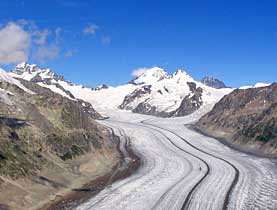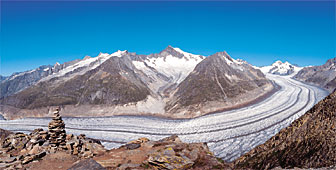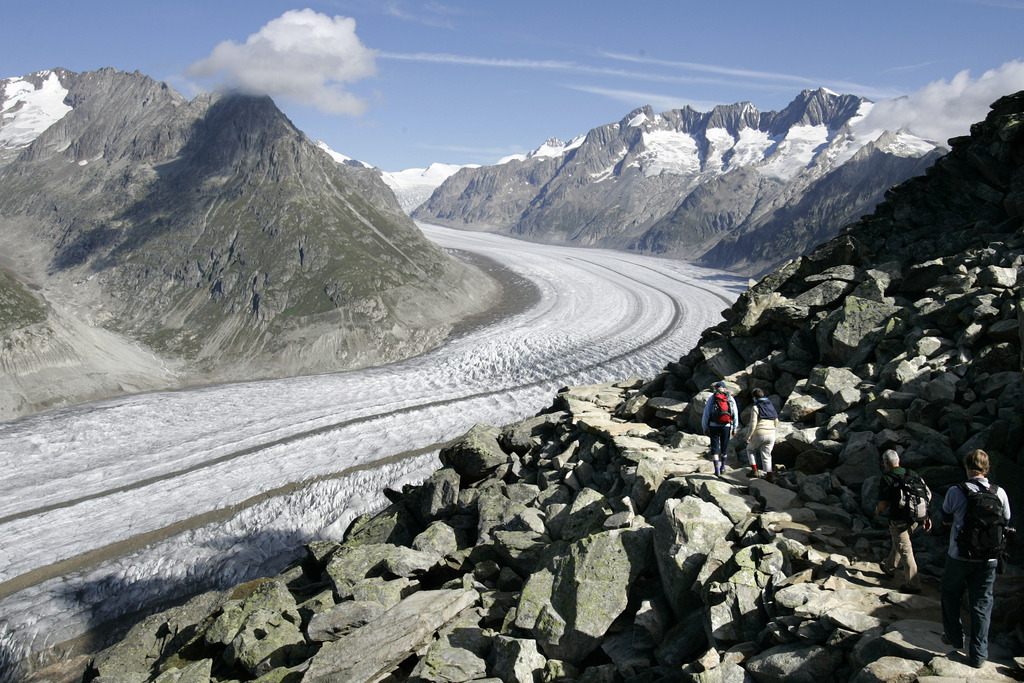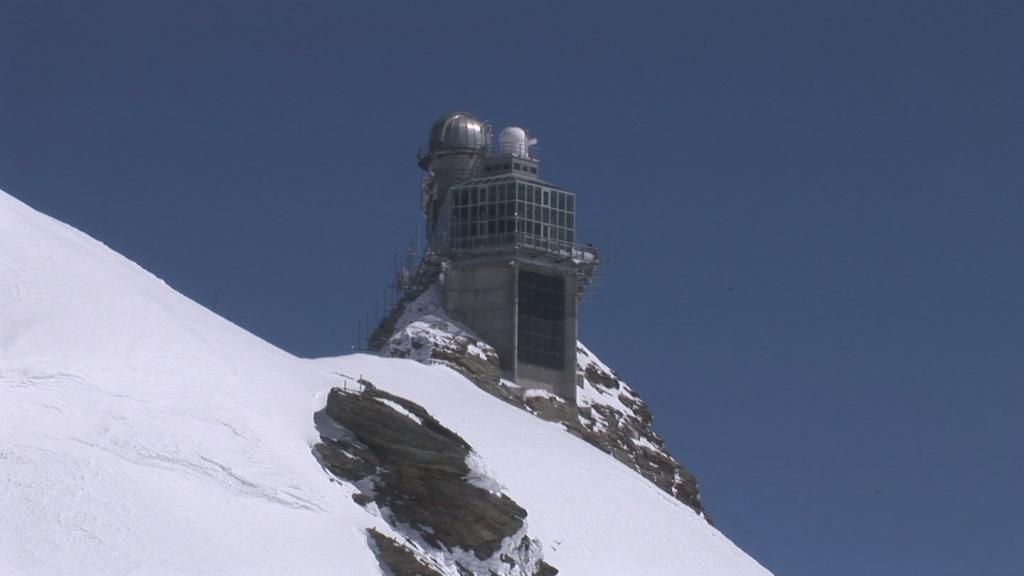An alpine kingdom of rock and ice

Featuring majestic peaks, sheer rock faces, and an immense tongue of ice, the Jungfrau-Aletsch Unesco World Natural Heritage Site is certainly impressive.
The protected area, which lies between the Bernese Oberland and northeastern Valais, covers more than 800 kilometres² and is the first site of its kind in the Alps.
Countless roads, trails, cableways, ski-lifts and mountain railways – the best known being the Jungfrau line – lead up to the protected area and, in some cases, breach its borders. A dense network of trails criss-crosses the outer fringes. But its inner core remains virtually inaccessible, except for eagles and mountaineers.
The site includes famous mountains such as the Jungfrau-Eiger-Mönch triad, the Bietschhorn, the Wetterhorn, the Schreckhorn and the Finsteraarhorn – the highest peak in the area at 4,274 metres. Nine mountains break the 4,000-metre barrier and a further fifty the 3,500-metre mark. An area of around 350 km² is covered in glaciers.
The wild, inhospitable landscape has fascinated generations of artists and travellers in search of unspoilt natural scenery in an increasingly industrialised Europe.
However, some of the outer parts of the site bear witness to human intervention and are shaped by the work of farmers and the daily life of mountain communities.
Not just mountains
“For us it has always been important to include the surrounding cultural landscape in the Jungfrau-Aletsch area,” said Beat Ruppen, director of the Unesco management centre at Naters in Valais, as he showed us photographs of the steep sheep-tracks leading up to the Aletsch meadows and the Alpine irrigation channels used to water pastures.
More cultural areas were added to the site with Unesco’s approval in 2007 when protected area was extended eastward to the Grimsel Pass and Meiringen, and westward to Lake Öschinen (Kandersteg) and the lower part of the Lötschental.
But the long Unesco application process was not without controversy, as local people feared that their region would be subject to too many environmental regulations.
The first proposal to register the Aletsch region as a World Natural Heritage Site was put forward in the 1960s. The idea was met with widespread scepticism from the local population and the project ground to a halt.
In the 1980s more than 90 per cent of the area now included in the site was listed in the Swiss federal inventory of landscapes of national importance.
Border queries
This decision partly defused the fear of over-burdensome regulations, and in 1996 paved the way for a fresh application to Unesco. In the event, Unesco’s regulations do not go beyond those already laid down by the federal authorities.
There were also lengthy negotiations on defining the boundaries of the site.
“We adopted a participatory model, involving the local community in the discussions. It was a long process, but it enabled people living in the area to grasp the importance of Unesco registration,” explained Ruppen.
Even so, most of the areas of economic interest were eventually excluded. Ruppen clearly understands the viewpoint of people living in the Alps. “Without the prospect of economic development, these regions are in danger of abandonment. And this can hardly be the objective of a Unesco site,” he said.
Living with Unesco
The Jungfrau-Aletsch-Bietschhorn region was added to the Unesco World Heritage list in 2001. Following its enlargement in 2007, the site was renamed Swiss Alps Jungfrau-Aletsch. Since then, even the locals have discovered the advantages of Unesco recognition.
“People are proud to live in a region considered to be part of the world’s natural heritage. It has strengthened local identity,” said Ruppen.
The Unesco name and logo is on display everywhere. Even those who were initially sceptical now use it to advertise their activities.
The next challenge is to achieve a sustainable balance between environmental protection and economic development.
Global warming is placing more pressure on tourism in mountain regions. The municipalities responsible for the Unesco site are therefore committed to promoting sustainable development.
In 2001 they signed up to an environmental charter in the hope that glaciers, mountains and humans will continue to coexist for centuries to come.
Andrea Tognina in Naters, swissinfo.ch
Total area: 824 km²
Area covered in ice: 46%
Area without vegetation: 80%
In Canton Bern: 43%
In Canton Valais: 57%
Municipalities involved: 26, eight in Canton Bern, 18 in Canton Valais.
At the centre of the site, known as the Place de la Concorde, the ice is 900 metres thick.
Extending for 23 km, the Aletsch glacier is the longest in Europe.
The extension of the natural World Heritage property of Jungfrau – Aletsch – Bietschhorn (first inscribed in 2001), expands the site to the east and west, bringing its surface area up to 82,400 hectares, up from 53,900 ha.
The site provides an outstanding example of the formation of the High Alps, including the most glaciated part of the mountain range and the largest glacier in Eurasia. It features a wide diversity of ecosystems, including successional stages due particularly to the retreat of glaciers resulting from climate change.
The site is of outstanding universal value both for its beauty and for the wealth of information it contains about the formation of mountains and glaciers, as well as ongoing climate change. It is also invaluable in terms of the ecological and biological processes it illustrates, notably through plan succession. Its impressive landscape has played an important role in European art, literature, mountaineering and alpine tourism.
Source: Unesco

In compliance with the JTI standards
More: SWI swissinfo.ch certified by the Journalism Trust Initiative



You can find an overview of ongoing debates with our journalists here. Please join us!
If you want to start a conversation about a topic raised in this article or want to report factual errors, email us at english@swissinfo.ch.